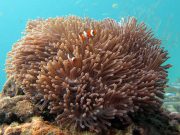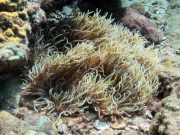Diving with Carpet Anemones
Lanta Marine Life | Stichodactylidae
Carpet Anemones are a group of predatory invertebrates that get their name from the vibrant terrestrial flower, the Anemone. There are more than 1,000 species found around the world's oceans at various depths, the largest and most varied occur in coastal tropical waters. They are found in abundance at all sites on our Koh Lanta diving trips.
A close relative of Coral and Jellyfish, Anemones are stinging polyps, ranging from 5mm to 2mtr in diameter, with 10 to over 500 tentacles! They spend their time attached to the substrate by an adhesive foot, called the Basal Disc. Their bodies are cylindrical with an array of tentacles surrounding a central mouth which is also their anus. They dine on passing plankton, small fish and small crustaceans. The slightest touch will trigger the tentacles, firing harpoon-like filaments into their victim, injecting a paralysing neurotoxin and guiding the helpless prey into the mouth.
Some animals have found away to exploit the defence against itself and have established symbiotic relationships. The most famous symbiotic alliances are with Anemone Fish and Porcelain Crabs. They coat themselves with the mucus which tricks the Anemone into thinking they are part of itself, making them also immune to the sting. These partners live within the tentacles, which provide protection, and the Anemone snacks on the scraps from their meals.
Some Anemones reproduce by lateral fission where an identical animal will grow from the parent, break away and become independent. Many though will spawn into the water where the eggs and sperm will mix. The young will join the plankton layers and when old enough, will settle to a substrate.
3 species found on this page:
Magnificent Sea Anemone
(Heteractis magnifica)

Heteractis magnifica @ Koh Rok
The Magnificent Sea Anemone is found attached to solid surfaces such as rock or dead coral and is found from the shallows to deeper water, usually in exposed areas where medium to strong currents can supply food.
The Magnificent Sea Anemone has a wide oral disc which can reach more than 50 cm across, but most often observed much smaller than this. The oral disc can open to a flat surface, is slightly wavy and is densely spotted with finger-line tentacles which are positioned in multiples of six (member of the six-part corals, Hexacorallia). The tentacles are 5 cm - 8 cm long with blunt or slightly bubble-like tips. The tips may be yellow, green or white.
The Magnificent Sea Anemone can have a variety of colours, with the Basal disc (sticky foot) and column being greyish, greenish or pinkish, purple or brownish. When disturbed, the oral disc will close, with only a few tentacles showing. In extreme cases of disturbance of a change in environmental factors, the Magnificent Sea Anemone can relocate.
Beaded Sea Anemone
(Heteractis aurora)

Juvenile Heteractis aurora @ Koh Bida
The Beaded Sea Anemone is easy to identify because of the numerous small bubbles or beads on each tentacle. In younger specimens, the beads are less developed and the tentacles are shorter, however as the tentacles grow, the beads develop into larger bubbles. Longer tentacles may have many dozens of beads or bubbles.
Since most of the tentacles are in the outer part of the anemone, the oral disc is relatively plain. There can be light brownish radial lines on the oral disc which extend into the sticky tentacles.
The underside of the oral disc and column can be grey-green to chestnut-brown. This anemone displays a variety of colours depending on the surrounding environment and the amount of zooxanthellae in the tissues.
This species can be host to several different species of anemonefish and also to the Three Spot Domino Damselfish (Dascyllus trimaculatus), however it is most commonly observed hosting Clarke’s Anemonefish (Amphiprion clarkii).
The Beaded Sea Anemone is often a temporary home for young clownfish on their journey to find a more suitable host anemone for adulthood, and is also known as a 'nursery' anemone.
Purple Tip Anemone
(Heteractis crispa)

Heteractis crispa @ Koh Bida
The Purple Tip Anemone, or Leathery Anemone, lives between corals and sand covered hardgrounds.
Colour can vary widely and depends on the amount of zooxanthellae in the tissues.
The body column is usually grey and the oral disk is often brownish violet or grey, but can also be bright green, occasionally with white stripes.
The Purple Tip Anemone has long, curled tentacles which become thinner toward the tip, and are positioned in concentric circles on the leathery oral disc. The oral disc and the tentacles have the same colour. The tentacle tips can often show a slightly different colour and may have a tiny purplish or greenish-blue spot at the tip center.
The Purple Tip Anemone can grow up to 30 cm in diameter and feeds mostly on products of its zooxanthellae.
This species is usually found among dead coral and rock rubble and lives in symbiosis with several different species of anemonefish and shrimp (genus Periclimenes).
Diving with Carpet Anemones around Koh Lanta
Scuba Diving & Snorkel Trips
If you'd love a chance to spot Carpet Anemones on one of our daily high season diving trips from Koh Lanta then send us an email to info@diveandrelax.com.
Join our high season speedboat dive trips to some of Thailand's best dive sites and enjoy small groups, short journey times, with a focus on great personal service, safety and fun.
Not yet a certified diver? Learn to Scuba Dive on Koh Lanta with the 3 day SSI Open Water Diver course.
Book online to save 10% on dive trips and scuba courses on Koh Lanta.
Find Out More
Indo-Pacific Marine Life Guides
- Allen, G., Steene, R., Humann, P., DeLoach, N. (2003) Reef Fish Identification, Tropical Pacific. Jacksonville, FL., USA: New World Publications, Inc., ISBN 1-878348-36-1.
- Humann, P., DeLoach, N., (2010) Reef Creature Identification, Tropical Pacific. Jacksonville, FL., USA: New World Publications Inc., ISBN 978-1-878348-44-9
- Debelius, H. (2013) Indian Ocean Reef Guide. Frankfurt, Germany: IKAN - Unterwasserarchiv, ISBN 978-3-939767-52-7.
- Debelius, H. (2004) Nudibranchs and Sea Snails, Indo-Pacific Field Guide. Frankfurt, Germany: IKAN - Unterwasserarchiv, ISBN 3-925919-51-1
- Erhardt, H., Knop, D. (2015) Corals Indo-Pacific Field Guide. Frankfurt, Germany: IKAN - Unterwasserarchiv, ISBN 3-925919-69-4.
- Veron J.E.N., Stafford-Smith M.G., Turak E. and DeVantier L.M. (2016). Corals of the World
